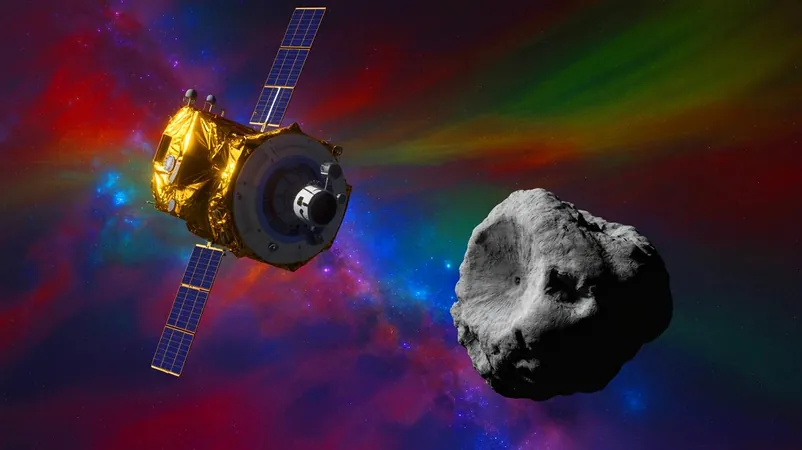
Japan’s Hayabusa2 Set to Encounter the Smallest Asteroid Yet – A Scientific Adventure
2025-09-20
Author: Ying
A Game-Changing Discovery in the Cosmos
Recent astronomical observations have dramatically reshaped our understanding of asteroid 1998 KY26, the new target for Japan’s Hayabusa2 spacecraft. Originally estimated at 30 meters wide, scientists now confirm this diminutive body measures just 11 meters across, marking it as the smallest asteroid ever targeted for exploration. This unexpected finding has injected both excitement and complexity into the mission, as the asteroid's rapid rotation and minute size pose unprecedented challenges.
Navigating the Challenges of a Miniature Giant
Japan’s Hayabusa2, famed for its successful sample return from the larger asteroid Ryugu in 2020, is venturing forth once again—this time to meet the tiny asteroid 1998 KY26. A first in space missions aimed at such small celestial bodies, this audacious endeavor comes with a host of new complications.
The dimensions of KY26 are astonishingly comparable to the Hayabusa2 spacecraft itself, making orbital maneuvers and surface contact exceptionally tricky. Complicating matters further is KY26's incredible rotation speed: it completes a spin every five minutes! As Toni Santana-Ros from the University of Alicante highlighted, a day on this asteroid lasts just five minutes, showcasing the need for extraordinary precision in the mission’s execution.
Unlocking the Secrets of Tiny Asteroids
Studying asteroid 1998 KY26 opens up a treasure trove of insights into objects that often elude detailed observation. The asteroid's bright surface hints at a solid rock structure, although it may also be a loosely aggregated rubble pile. As scientists like Santana-Ros note, the challenge presented by such a small target makes this mission groundbreaking in the realm of space exploration.
Understanding these smaller bodies is not just a matter of scientific fun—it can have wider implications for future explorations, including potential asteroid mining and enhanced planetary defense strategies. The 2013 Chelyabinsk event, where a similarly sized asteroid exploded in the atmosphere, underscores the critical need to understand and monitor these cosmic threats.
Technological Triumphs in Discovery
The insights gained about KY26 are thanks to cutting-edge observational techniques and technologies. A global team of astronomers improved measurements of the asteroid’s size and rotation using advanced facilities like the Very Large Telescope in Chile, demonstrating remarkable precision in a challenge that seems to diminish the farther away the object is.
These advancements in telescope technology and data analysis expand our capabilities not only for scientific inquiry but also for practical applications in space exploration and defense. The potential success of Hayabusa2's mission heralds a bright future for studying other small celestial bodies.
The Unfolding Future of Asteroid Exploration
As Hayabusa2 gears up for its encounter with KY26, this mission stands as a beacon for the future of asteroid exploration. The unique challenges presented by this minuscule, speedy asteroid will push the limits of current technology, and the rewards of this mission could provide invaluable insights into the complexities of small celestial objects.
The implications of this research stretch far and wide—from potential resource extraction from asteroids to strategies for safeguarding Earth against potential impacts. As we embark on this thrilling new chapter in space exploration, we are left wondering: how will these groundbreaking discoveries transform our understanding of the universe and our place within it?



 Brasil (PT)
Brasil (PT)
 Canada (EN)
Canada (EN)
 Chile (ES)
Chile (ES)
 Česko (CS)
Česko (CS)
 대한민국 (KO)
대한민국 (KO)
 España (ES)
España (ES)
 France (FR)
France (FR)
 Hong Kong (EN)
Hong Kong (EN)
 Italia (IT)
Italia (IT)
 日本 (JA)
日本 (JA)
 Magyarország (HU)
Magyarország (HU)
 Norge (NO)
Norge (NO)
 Polska (PL)
Polska (PL)
 Schweiz (DE)
Schweiz (DE)
 Singapore (EN)
Singapore (EN)
 Sverige (SV)
Sverige (SV)
 Suomi (FI)
Suomi (FI)
 Türkiye (TR)
Türkiye (TR)
 الإمارات العربية المتحدة (AR)
الإمارات العربية المتحدة (AR)